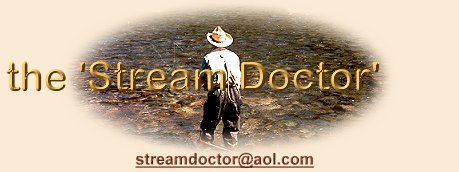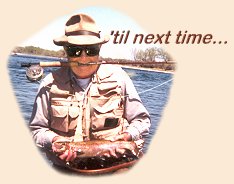
| ||
|
February 28th, 2005
|
|
Q. The Esopus Creek in the Catskills of NY has been steadily declining as a once pristine water and fishery. We are presently suing NYC DEP to restore this stream back to its original state. What I want to know is, what affects does sedimentation and turbidity have on aquatic life, the spawning of rainbows and browns and the future of a stream, with this famous stream being now known as the Yoo-Hoo Creek?
A.
A good question, and one that has several facets
to it. Let me address the impacts of sedimentation
on the different levels of the food chain.
Algae/diatoms: These organisms form the
base of the food web, or at least one of the main
bases, and is impacted by sedimentation in three
ways. First, by its presence in the water column,
suspended sediments (turbidity) decrease the amount
of sunlight penetrating to the bottom of the stream,
thus effectively shading the algae/diatoms and
decreasing their potential for production of
oxygen and growth. Second, the suspended
sediments act as an abrasive, effectively
scouring algae/diatoms from the substrate.
Third, suspended sediments that settle to
the bottom cover the algae/diatoms present,
thus cutting them off from both light and
oxygenated water and resulting in their death.
All of these impacts decrease the amount of
algae/diatoms on the bottom, the prime food
resource for the grazing/scraping insects.
Invertebrates: Immature insects that
utilize the surface of stones for either their
food source (grazers/scrapers) or living site
(many filterers) are impacted by sedimentation.
The former are impacted as described above, and
the latter are impacted by being smothered from
sediments that settle on them. Fine sediments
are extremely detrimental to mayflies because
they settle on and adhere to their gills,
effectively smothering them. Sediments that
settle and fill the spaces between stones on
the bottom of streams effectively eliminate
these sites for habitation by invertebrates
that seek out these places for shelter and food.
Trout: Again, there is a dual impact
here. First of all, if the sediments settle
and fill up the spaces between the gravels
that trout prefer for spawning, the fish will
simply avoid these places for digging their
redds. Secondly, if sedimentation occurs after
the fish have spawned, it will fill the spaces
between the gravels and prevent the flow of
aerated water to the developing eggs - smothering
and killing them.
That's what sediments do to organisms in the
streams; the future, obviously, is pretty bleak.
If you have a question, please feel free to contact me.
|
| If you would like to comment on this or any other article please feel free to post your views on the FAOL Bulletin Board! |
 The 'Stream Doctor' is a retired professional stream ecologist and
author, now living in the West and spending way too much time
fly-fishing. You are invited to submit questions relating to
anything stream related directly to him for use in this Q & A Feature
at
The 'Stream Doctor' is a retired professional stream ecologist and
author, now living in the West and spending way too much time
fly-fishing. You are invited to submit questions relating to
anything stream related directly to him for use in this Q & A Feature
at